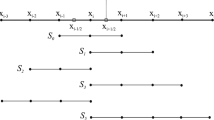Abstract
An entirely new approach to the large-eddy simulation (LES) of high-speed compressible turbulent flows is presented. Subgrid scale stress models are proposed that are dimensionless functions of the computational mesh size times a Reynolds stress model. This allows a DNS to go continuously to an LES and then a Reynolds-averaged Navier–Stokes (RANS) computation as the mesh becomes successively more coarse or the Reynolds number becomes much larger. Here, the level of discretization is parameterized by the nondimensional ratio of the computational mesh size to the Kolmogorov length scale. The Reynolds stress model is based on a state-of-the-art two-equation model whose enhanced performance is documented in detail in a variety of benchmark flows. It contains many of the most recent advances in compressible turbulence modeling. Applications to the high-speed aerodynamic flows of technological importance are briefly discussed.
Similar content being viewed by others
REFERENCES
Abid, R., and Speziale, C. G. (1996). The freestream matching condition for stagnation point turbulent flows: An alternative formulation. ASME J. Appl. Mech. 63, 95-100.
Abid, R., Morrison, J. H., Gatski, T. B., and Speziale, C. G. (1996). Prediction of aerodynamic flows with a new explicit algebraic stress model. AIAA J. 34, 2632-2635.
Bardina, J., Ferziger, J. H., and Reynolds, W. C.,(1983). Improved Turbulence Models Based on Large-Eddy Simulation of Homogeneous, Incompressible Turbulent Flows. Stanford University Technical Report No. TF-19.
Cebeci, T., and Smith, A. M. O. (1974). Analysis of Turbulent Boundary Layers, Academic Press, New York.
Eaton, J. K., and Johnston, J. P. (1980). Turbulent Flow Reattachment: An Experimental Study of the Flow and Structure Behind a Backward Facing Step. Stanford University Report No. MD-39.
Erlebacher, G., Hussaini, M. Y., Speziale, C. G., and Zang, T. A. (1992). Toward the large-eddy simulation of compressible turbulent flows. Fluid Mech. 238, 155-185.
Ferziger, J. H. (1976). Large-eddy simulation of turbulent flows. AIAA Paper No. 76-347.
Gatski, T. B., and Speziale, C. G. (1993). On explicit algebraic stress models for complex turbulent flows. J. Fluid Mech. 254, 59-78.
Germano, M., Piomelli, U., Moin, P., and Cabot, W. H. (1991). A dynamic subgrid-scale eddy viscosity model. Phys. Fluids 3, 1760-1765.
Huang, P. G., Bradshaw, P., and Coakley, T. J. (1994). Turbulence models for compressible boundary layers. AIAA J. 32, 735-740.
Hussaini, M. Y., Speziale, C. G., and Zang, T. A. (1990). Discussion of the potential and limitations of direct and large-eddy simulations. Lecture Notes Phys. 357, 354-368.
Johnston, J. P., Halleen, R. M., and Lezius, D. K. (1972). Effects of a spanwise rotation on the structure of two-dimensional fully-developed turbulent channel flow. J. Fluid Mech. 56, 533-557.
Kim, J., Kline, S. J., and Johnston, J. P. (1980). Investigation of a reattaching turbulent shear layer: Flow over a backward facing step. ASME J. Fluids Eng. 102, 302-308.
Kussoy, M. I., and Horstman, C. C. (1991). Documentation of Two-and Three-Dimensional Shock Wave/Turbulent Boundary Layer Interaction Flows at Mach 8.2. NASA TM-103838.
Leonard, A. (1974). On the energy cascade in large-eddy simulations of turbulent flows. Adv. Geophys. A 18, 237-248.
Reynolds, W. C. (1987). Fundamentals of Turbulence for Turbulence Modeling and Simulation. Lecture Notes for Von Kármán Institute, AGARD Lect. Ser. No. 86, NATO, New York, pp. 1-66.
Rogallo, R. S., and Moin, P. (1984). Numerical simulation of turbulent flows. Ann. Rev. Fluid Mech. 16, 99-137.
Sarkar, S. (1992). The pressure-dilatation correlation in compressible flows. Phys. Fluids A 4, 2674-2682.
Sarkar, S., Erlebacher, G., and Hussaini, M. Y. (1991). Direct simulation of compressible turbulence in a shear flow. Theor. and Comp. Fluid Dyn. 2, 291-305.
Schmitt, V., and Charpin, F (1979). Pressure Distribution on the ONERA M6 Wing at Transonic Mach Numbers. AGARD-AR-138, NATO, New York.
Smagorinsky, J. (1963). General circulation experiments with the primitive equations. Mon. Weather Rev. 91, 99-165.
Speziale, C. G. (1987). On nonlinear K-ι and K-ε models of turbulence. J. Fluid Mech. 178, 459-475.
Speziale, C. G. (1996). Modeling of Turbulent Transport Equations. In Gatski, T. B., Hussaini, M. Y., and Lumley, J. L. (eds.), Simulation and Modeling of Turbulent Flows, Oxford University Press, New York, pp. 185-242.
Speziale, C. G., and Abid, R. (1995). Near-wall integration of Reynolds stress turbulence closures with no wall damping. AIAA J. 33, 1974-1977.
Speziale, C. G., and Ngo, T. (1988). Numerical solution of turbulent flow past a backward facing step using a nonlinear K-ε model. Int. J. Eng. Sci. 26, 1099-1112.
Speziale, C. G., and Sarkar, S. (1991). Second-Order Closure Models for Supersonic Turbulent Flows. AIAA No. 91-0217.
Speziale, C. G., and Xu, X. H. (1996). Towards the development of second-order closure models for non-equilibrium turbulent flows. Int. J. Heat Fluid Flow 17, 238-244.
Speziale, C. G., Abid, R., and Anderson, E. C. (1992). Critical evaluation of two-equation models for near-wall turbulence. AIAA J. 30, 324-331.
Wieghardt, K., and Tillman, W. (1951). On the Turbulent Friction Layer for Rising Pressure? NACA TM 1314.
Yoshizawa, A. (1984). Statistical analysis of the deviation of the Reynolds stress from its eddy viscosity representation. Phys. Fluids 27, 1377-1387.
Zeman, O. (1990). Dilatational dissipation: The concept and application in modeling compressible mixing layers. Phys. Fluids A 2, 178-188.
Zhang, H. S., So, R. M. C., Speziale, C. G., and Lai, Y. G. (1990). Near-wall two-equation model for compressible turbulent flows. AIAA J. 31, 196-199.
Author information
Authors and Affiliations
Rights and permissions
About this article
Cite this article
Speziale, C.G. A Combined Large-Eddy Simulation and Time-Dependent RANS Capability for High-Speed Compressible Flows. Journal of Scientific Computing 13, 253–274 (1998). https://doi.org/10.1023/A:1023266932231
Issue Date:
DOI: https://doi.org/10.1023/A:1023266932231




